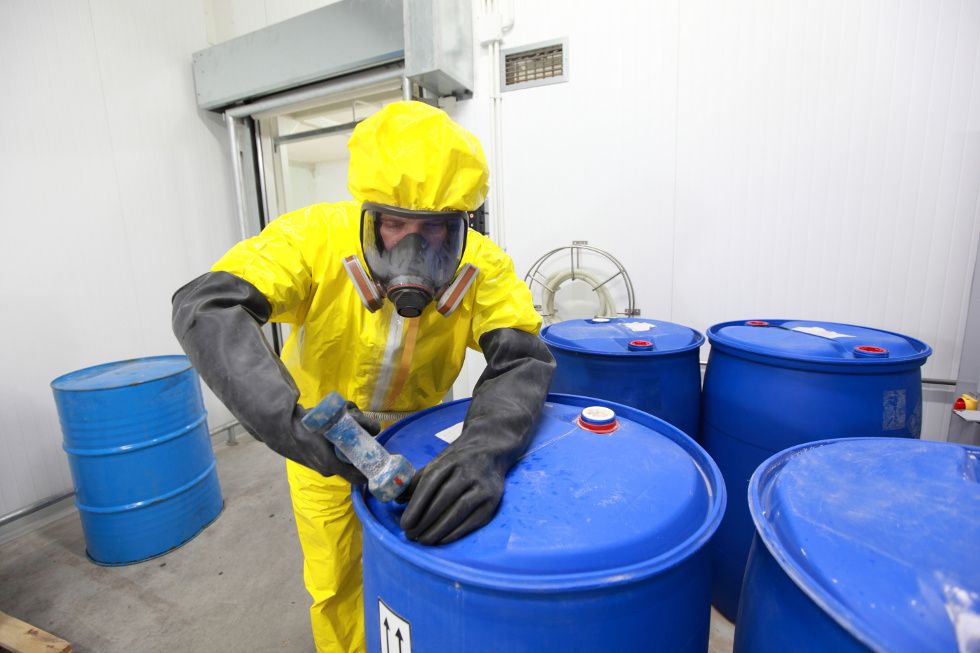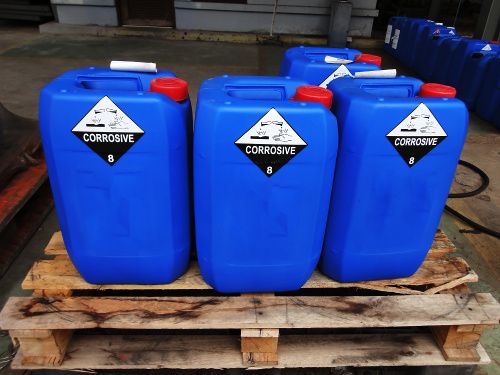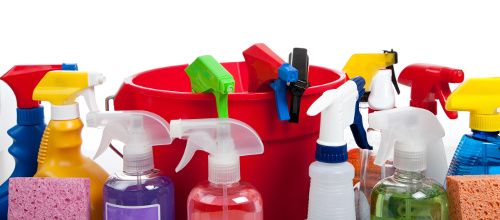Food processing and manufacturing facilities must be kept clean and sanitary to protect food safety and prevent foodborne illness. Chemical soaps, detergents, sanitizers and disinfectants are routinely used to help keep food free of unwanted microorganisms and other contaminants. These chemicals are vital to the safety and success of any food production process, but they can also be hazardous. Employees who use them or work around them need to understand their hazards and know how to protect themselves.
What Chemicals Are Used in Food Processing/Manufacturing?
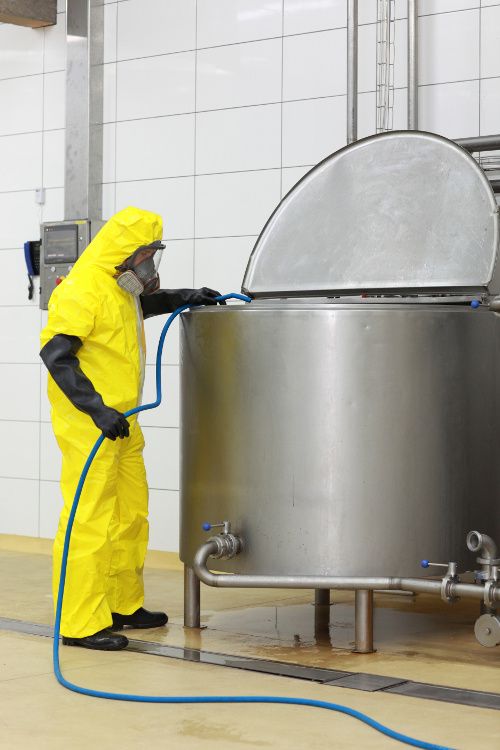
- To clean, sanitize or disinfect surfaces, chemicals must be able to kill microorganisms such as bacteria, viruses, and fungi
- Most sanitizing and disinfecting chemicals you find in food production can kill microorganisms because they are corrosive
- Different corrosives can damage different materials, including metals and a variety of organic compounds, but almost all are capable of irritating, damaging or even destroying living tissue on contact
- This makes them great for killing microorganisms, but unfortunately it means they can also be harmful for people who must handle them
- Corrosive chemicals can irritate or damage most types of body tissue
- If corrosive chemicals get onto your skin they can cause itching, swelling, rashes, and chemical burns
- If they get into your eyes they can cause irritation or even serious eye damage
- If you breathe them in, corrosive chemicals can irritate the sensitive tissues in your nose, throat and lungs, and can cause breathing problems or trigger asthma
- If accidentally swallowed they can cause damage to the mouth, throat, stomach and intestines
- In addition to being corrosive, some of these chemicals are also toxic and can make you very sick
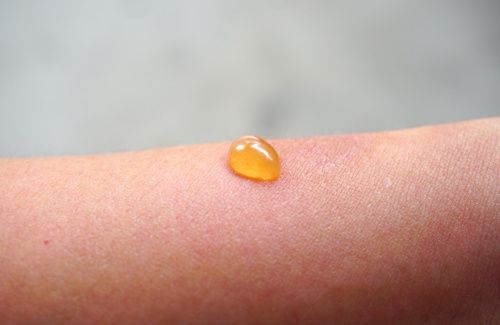
- How you are exposed to the chemical. If some bleach spills on your skin it might only cause some minor skin irritation, but if you inhale bleach fumes it could cause serious breathing problems.
- The dose, or the amount of the chemical that enters your body
- The concentration of the chemical
- Your age, size, gender, and overall health can all impact the way you react to a chemical exposure
Chemical container labels are a great way to tell at a glance what kind of hazards a chemical may present. The Occupational Safety and Health Administration, or OSHA, requires that chemical manufacturers use the Globally Harmonized System of Classification and Labeling of Chemicals, or GHS, on labels for hazardous industrial chemicals. GHS labels require one or more of nine possible pictograms, which will allow workers to quickly identify the types of chemical hazards. The
label will also require a signal word, which is a single word that indicates the relative level of severity of the hazard. These signal words are “DANGER” or “WARNING”, with “DANGER” indicating more immediate or more extreme hazards.
There must also be a hazard statement, which describes the nature of the hazard, and a precautionary statement, which describes recommended measures to minimize adverse effects of exposure to that chemical. A product identifier, which is the chemical identity of the substance, is also required to be on the label. Finally, the supplier’s information, including the name, address, and telephone number, should be on the label. OSHA requires your employer to make sure all hazardous chemicals in your facility have either their original, GHS-compliant manufacturer labels, or equivalent workplace labels.
The GHS uses nine standard pictograms:
| Health Hazard | Oxidizers | Irritant |
| Corrosives | Flammables | Environmental Toxicity |
| Acute toxicity | Gases Under Pressure | Explosives |
There are some other chemical containers you may see in the workplace. Chemicals which are not considered very hazardous will have much simpler labels without all the warning information. You may also encounter hazardous cleaning chemicals in packagings that have standard consumer labels instead of industrial GHS labels.
For more detailed information about the hazards of a particular chemical, you can consult the Safety Data Sheet, or SDS. SDSs will contain 16 sections:
- Identification
- Hazard identification
- Composition and information on ingredients
- First-aid measures
- Fire-fighting measures
- Accidental release measures
- Handling and storage
- Exposure controls and PPE
- Physical and chemical properties
- Stability and reactivity
- Toxicological information
- Ecological information
- Disposal considerations
- Transport information
- Regulatory information
- Other information
Your employer is required to make sure there is an SDS available for each hazardous chemical in the workplace. The SDSs must be readily accessible, in a location known to employees.
Before handling any chemical product for the first time:
- Read the label, SDS and any company process sheets, wall charts or other information about the chemical and how to use it
- Be sure you have ready access to the SDS while using the chemical, in case you need to refer to it during an emergency
- Only handle chemicals when you have the proper ventilation and protective equipment, as indicated on the SDS
- Only use chemicals for their intended purpose, and only use them as directed on the label or process sheet
- When you are done using chemicals, make sure to follow all procedures for disposing of used chemicals and empty containers
- Ensure that all waste containers are properly marked, and always keep waste chemicals separate from unused chemicals
- Be sure that you know and follow any other required procedures
- Observe careful hygiene practices when handling chemicals
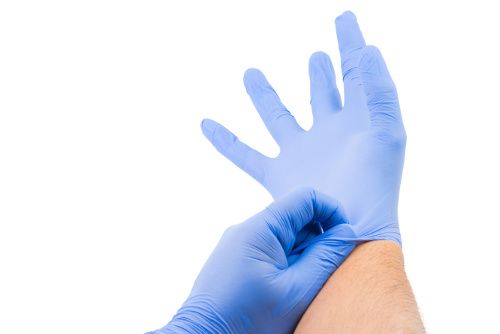
- Always wear gloves which can protect your skin from that chemical
- Check the SDS to know what types of glove materials work best
- Gloves for cleaning, sanitizing and disinfecting procedures should cover your forearms, not stop at your wrist
- Aprons or coveralls should be worn to keep chemicals off your clothes
- Eye protection such as chemical splash goggles are also strongly recommended, especially if there is a risk of spraying or splashing chemicals
- Waterproof, slip-resistant footwear is also recommended anywhere liquids may be present on the floor
- In some rare instances, it may be necessary for you to wear respiratory protection (If you are required to wear respiratory protection, you will need additional training over how to wear it properly, and will need to undergo a medical evaluation and fit test)
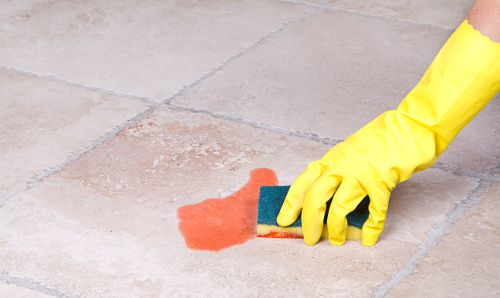
- Only dispense from one container at a time
- Put the cap back on the container and wipe the outside clean before opening another container
- Dispense as little as possible, trying to only take what you need right now
- Avoid spills and reduce the amount of dust, mist, vapor or fumes that leave the container and get into the air
- Open the container slowly, avoid shaking or squeezing it, and follow any other instructions on the container
- Be sure that the container you are pouring into is stable and large enough
- Never squeeze a container or use pressurized air to push out the contents unless the procedure specifically calls for it
- Never use your mouth to siphon liquid out of a container
- Be sure any container you put the chemical into, and any scoops, funnels or other tools that you use to move the chemical, are made of appropriate materials that won’t be damaged by the chemical
Never mix chemicals together unless specifically directed to do so by a supervisor or process sheet.
Many sanitizing and disinfecting chemicals will come to your facility in highly-concentrated forms, and you will need to dilute them with water in order to make a usable solution:
- When diluting, always add the chemical to the water, not the other way around, and add it slowly
- If you need to dilute a powder or granulated solid, mix a small amount of water with the solid to make a slurry, then add that to the rest of the water
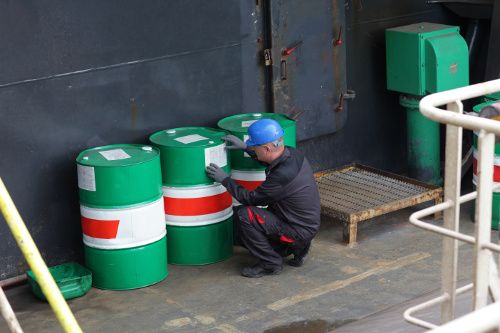
- Never accept delivery of defective or unlabeled containers
- In general, you should always store chemicals separately from other materials, especially food ingredients, and away from processing and handling areas
- You should also keep incompatible chemicals separate from each other
- Keep liquids separate from solids, keep acids separate from bases, and keep flammable chemicals away from combustible materials and ignition sources
- Always store chemicals in appropriate containers as recommended by the manufacturer
- Make sure that chemicals are always properly labeled and that labels are undamaged, facing forward and easy to read
- Keep all containers tightly closed except when the contents are being used
- Protect containers against banging or other physical damage during storage and handling
- Store containers at a convenient height for safe lifting and handling, below eye level if possible
- Always keep storage areas clean, organized, and free of trash and clutter
- Clean up any spills promptly, following the procedures outlined in your facility policies
- If chemical containers become swollen, notify your supervisor immediately
Storage areas should be well lit, well ventilated, and dry. Temperatures should be carefully maintained according to the manufacturer’s recommendations:
- Chemicals for cleaning, disinfecting and sanitizing should be kept away from direct sunlight, leaky pipes, steam pipes, boilers, and any other sources of heat or water
- Walls, floors and shelving should be resistant to corrosion and should not react with the chemicals being stored
- Liquids should be stored with proper spill containment, and floors where liquids are stored should not allow liquids to penetrate
- Appropriate PPE and supplies for handling the chemicals should be kept in the store room or easily accessible nearby
- Firefighting equipment and supplies for cleaning up spills should be available in the storage areas
- Storage areas should be labeled with proper warning signs, and only trained and authorized personnel should be allowed inside
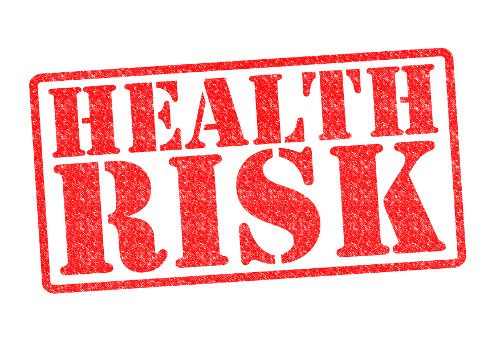
- Always respond to spills promptly, and carefully follow your facility policies and any instructions on the chemical’s SDS
- Do your best to control the scene and prevent people from walking through the area
- Spill cleanup kits with the materials you need should be readily available
- You should receive training over how to respond to spills and how to properly use spill kits
- Liquids should be absorbed by a disposable material that can hold the liquid and won’t react with the chemical
- All waste created by the spill – including the chemical itself, any absorbents used, and broken containers – should be placed into approved, marked, leak-proof containers and disposed of according to facility policy
- Always report any spill incidents to your supervisor as soon as possible

